How Close Can Pigs Be To Houses
Housing requirements for different categories of pigs
Shivani Singh, Argana A K, Dr. Anuj Chauhan, Dr. Mukesh Singh and Dr. Gyanendra Kumar Gaur
Livestock product direction division ,Indian Veterinary Research Institute, Izatnagar,Bareily.
Introduction
The swine population in India is projected to be 9.06 million, contributing for 1.69 pct of the country'due south full livestock population of 535.78 1000000. Indian pigs account for around 1% of the global squealer population (DAHDF,2019). Since the last census, the number of pigs has declined past 12.03 percent. Rural areas are dwelling to around 89.62 percent of all pigs. The yr 2019 (DAHDF). Several Northeastern states have shown growing or stable trends. Assam, Jharkhand, and Meghalaya have the highest growth rates of 28.3 percent, 32.69 per centum, and 29.99 per centum, respectively, while Uttar Pradesh and Bihar have the everyman. According to information, swine production accounts for 4.98 percent of overall meat output in Republic of india, with approximately 10.7 million pigs slaughtered in the preceding fiscal year. (APEDA three-year export statement, 2020; Basic Animal Husbandry & Fisheries Statistics, 2019).
The unabridged amount of meat produced in India in the fiscal year 2019 was approximately yard metric tonnes. Pigs make for 4.98 percent of full meat production in India. Approximately 10.7 million pigs were slaughtered in the preceding fiscal year. (APEDA three-year export statement, 2020; Basic Animal Husbandry & Fisheries Statistics, 2019).
Pig farming has get a assisting business organization due to advantageous economic characteristics such as being very prolific, having a higher growth rate, having a shorter generation interval, having a low cost of rearing, and having a high dressing per centum with greater feed conversion efficiency (Prasad et al. 2011). Pigs can be raised in three ways: extensively/free range, semi-intensively, or intensively. In Bharat, hog farming and the pork manufacture are shifting from a traditional to an intensive arrangement. Asian countries have grown intensive pig farming at a quicker rate than the rest of the world (Cameron 2000).
Because of the growing human population and urbanisation, the bulk of pig farmers, particularly those in peri–urban areas, are concerned about maximising available space for suitable pig housing. Housing is expensive at first, peculiarly with the recommended larger surface area allotment, which can discourage farmers from starting sus scrofa farming. Higher grunter space recommendations based on outdated housing standards are predicted to have an impact on the Indian pork industry's economic competitiveness. From three weeks on, the appropriate remainder between the number of pigs in the group and the available expanse is critical to the proper rearing of pigs (Bhat et al. 2010).
Efficient use of pen space without compromising hog productivity or well-being is critical for pork production (Anil et al. 2007). In India, very few research on space allowance in pigs have been conducted, and those that have been conducted accept either used varied group sizes/pens or have been limited to a specific growth phase (Sinha et al. 1990, Sharma et al. 2004). Sharma et al. (2004) determined that 0.9 m2/grunter assart outperformed 1.2 m2/pig assart, indicating that additional flooring space allowance is not desired.
Design of Pig housing
Grunter houses should be made to ensure optimum comfort for greater growth, too every bit to avoid dampness in the buildings. Pig housing is dependent on a farming system that varies according to the prevalent conditions in that surface area, as well every bit the financial situation of the farmers. The housing system should be designed to put as little strain on the land every bit possible, and information technology might be intensive, semi-intensive, or all-encompassing. The layout and manner of pig housing vary due to varying soil and climatic conditions.
Location of pig houses
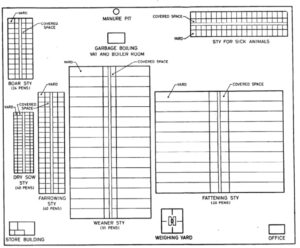
Structures should be congenital on a reasonably loftier and well-drained site that is non prone to floods, and the land should not exist clayey. Structures should exist at least 15 metres away from households, thirty metres away from dairies, animal and poultry houses, 45 metres away from fire sources, and one kilometre abroad from slaughterhouses and tanneries. The site's boundaries must be 50 metres away from the roads. A sufficient quantity of h2o should exist provided at the location.
Fig : Layout of a pig farm (BIS, 1966)
Table1. BIS infinite requirements
| SNo. | Type of animal | Covered floor expanse(grandii) | Open up yard area(yardii) |
| 1 | Boar | half dozen.25 to vii.5 | eight.8 to 12 |
| 2 | Farrowing sow | vii.five to 9 | eight.viii to 12 |
| 3 | Weaner /fattening sus scrofa | 0.96 to one.80 | 8.viii to 12 |
| 4 | Dry sow or gilt | 1.eighty to 2.70 | 1.4 to i.viii |
Table.2 Feeding and watering trough area requirement
| SNo. | Type of animal | Length (cm) |
| 1 | Boar | sixty to 75 |
| two | Sow and litter | 75 to 100 |
| 3 | Fattening pig | xxx to 40 |
| 4 | Weaner | xx to 30 |
The corporeality of water for boar, farrowing sow, fattening sow and dry sow will be about twoscore to 50l, 18- 20 l, 3.5 to 4l, and 4-5 50 respectively.
Houses for different categories of hog
Pigs are housed in Sties, which are separated into one or more pens, with each pen containing a single or group of animals based on age, sex, and purpose. The size of the pens is adamant past the number of animals to be kept and the flooring area provided per beast. Unlike sorts of Sties are available for different categories of pigs in big scale commercial piggeries for easier command.
Boar sty :
Protection of boars from temperature extremes is critical, since high temperatures can rapidly lead to decreased sperm fertility and libido. Strongly built boar accommodation is needed, peculiarly to prevent boars from escaping and fighting. Wire reinforcements can exist utilised for walls, yet door bolts and hinges must be of high quality. Each boar sty shall non contain more than 24 pens under one roof, with no more than than one animal per pen. The floor expanse of a boar pen should exist 7mtwo, merely if the pen is to be utilised for servicing, the minimum floor space need is 9m2.
Dry sow / gilt sty :
Each sty should not accept more than forty pens under one roof, and each pen should exist able to house two, five, or 10 animals depending on the stage of pregnancy. For well-nigh a calendar month after weaning her litter and for effectually two weeks before farrowing. Dry sow housing and feeding management are in a vital flow. Dry sows should be kept in containers, groups, or tethers.
Farrowing / nursing sow sty :
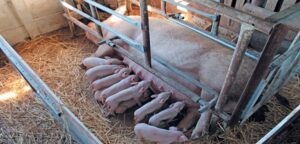
Fig: farrowing sty
Each farrowing sty normally has no more than 40 pens, with each pen housing one sow and her litter. The farrowing sty should be built with plenty space for the nursing sow to sleep and the piglets to movement around. Forth with the walls, piglet compartments in one or ii rows must be provided. Each compartment must be 2m loftier. Each compartment facing the nursing sow must take a 300225mm opening. Each compartment must have a watering and feeding trough. Guard rails shall be provided 25cm above the floor level.
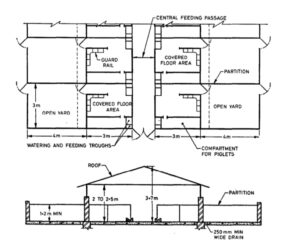
Fattening sty :
Each fattening sty typically has no more than 20 pens, with each pen housing sixteen-32 fattening animals.
Sty for weaner piglets :
Each sty should comprise no more than xxx pens, with each pen housing 10-twenty animals ranging in age from 2 to half dozen months.
Sty for ill animals :
A minimum of 5% of the stock must be gear up bated for sick animals, and the sty must be located at a suitable distance from the other locations to ensure adequate separation from salubrious animals.
Farrowing crate:
It is constructed using steel pipes or round steel rods. The container should be designed such that there is adequate open space backside her for piece of cake farrowing and to keep the piglets from beingness overwritten. Ample walking infinite should be provided for the piglets behind the sow. The container should exist 400 mm in a higher place the flooring, 450 – 500 mm broad, and 2500 mm long.
Pitter-patter expanse :
For the piglets, a 600mm by 600mm creeping pen with bedding must be given. For bedding, woods shavings are platonic. In a creeping pen, the ideal temperature ranges from 27°C to 32°C. Temperature variations of more v degrees Celsius must be avoided in the creep expanse. Infrared lamps can be used to go along the temperature stable.
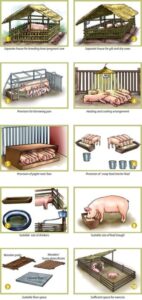
Constructional details of sties
Floor
The flooring should be sturdy and heated, water resistant, and elementary to make clean. Cement concrete floors tin be laid or paved with cement physical flooring tiles, stone slabs, or bricks set in cement mortar or lime mortar. Joints between stone slabs or bricks should be filled with binding cloth. The floor should gradient away from the drain. The height of the walls from the flooring must be between 2-two.v m. Up to two-thirds of the height of the wall can be built of bricks with cement mortar or lime mortar, and the remaining half of the wall tin be made of a succession of wooden rafters, each rafter measuring at to the lowest degree 2540 mm. The altitude between two rafter should not exceed 350 mm
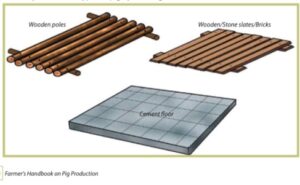
Fig: Types of flooring in swine housing
Roof
The roof could be RCC flat or gabled. Roof materials for gabled roofs may include asbestos, cement sheets or clay sheets, corrugated galvanised steel sheets, or dirt tiles. In the issue of extreme weather, the roof can be insulated by adding a layer of thatching or a ceiling to lessen the severity of heat inside the sty.
Doors
The number of doors in each sty is determined past its proportions. The doors must be robust and fitted so that they are near to the floor level. The doors must be robust and fitted so that they are near to the floor level. The door leaves might be synthetic of wood or galvanised steel sheets. Bending irons could be used to make the door frame. Individual pen doors can have a width of 1.2 to ane.v m and a height of 1.ii to 2 m.
Ventilators
Ventilators must be installed if the sites are closed on all sides. The number of ventilators necessary is adamant past the size of the sty. Each ventilator must be 0.6 1000 tall and 1 m long. The ventilator's top must be 0.v m above the highest point of the wall. Wire netting must exist used to cover each ventilator from the outside.
Drainage
For proper drainage, each sty must have at least one drain on one side. The drain must be at to the lowest degree 250 mm broad and slope 25 mm every x thou.
Subsidiary items
Weighing yard: The specifications for the weighing one thousand may differ from 1 location to the next. A weighing shed shall be provided, with a weighing scale installed to record the weights of the animals on a regular basis.
Store edifice : A store building may include a storekeeper'due south function, a mixing room for mixing animal feed, a room for storing miscellaneous items such as farm equipment and tools, and a feed store for majority storage of feed in bags.
Loading and unloading ramp : The farm shall have a permanent loading and unloading ramp.
Manure pit : The manure pit shall be built at a altitude of not less than 15 metres from the uttermost end of the sites and shall exist built in such a mode that the manure can be used for agriculture purposes.
Wallowing tank :
It may be available in pig convenance farms located in hot zones. The wallowing tank must be equanimous of cement concrete and have dimensions of at least two.51.20.15 thousand. During the summer, overhead sprinklers or showers may be installed to keep the animals cool.
HOUSING AND STOCKING DENSITY OF PIGS
Overstocking is done on purpose in some squealer farms; however, higher stocking density should exist used merely in very properly managed finishing units (Bhat et al. 2010). While developing flooring area recommendations for pigs, environmental enrichment strategies that accept into account natural pig behaviour should be prioritised. When group sizes of half dozen, 18, and 36 were maintained at a abiding floor infinite limit, group size had no outcome on feed intake, but bigger groups had lower feed conversion efficiency (FCE) (Petherick et al. 1989).
High stocking density has been shown to reduce the FCR of finishing pigs (leek et al. 2004). FCE is superior in terms of infinite (ane.4 m2/pig) than finisher pigs (i m2/pig) upwards to 160 kg body weight (Rossi et al. 2008). Pigs that were crowded (0.52 m2/pig) exhibited worse feed efficiency (ii.7 versus 2.five lb feed/lb gain, respectively) than pigs that were non crowded (0.78 m2/squealer), ADG was higher in the un-crowded pigs, and feeding time was shorter in the crowded pigs, with no departure between the two groups (street and Gonyou 2008). Crowding has a negative influence on growth generally considering it reduces feed intake. When growing-finishing pigs are provided less than optimal room per pig, feed intake always declines (Brumm et al. 2001), oftentimes resulting in a decrease in ADG with varying effects on the G:F ratio (Cho and Kim 2011). Crowding, on the other hand, has non been shown to enhance weight variation within a pen at slaughter (Kornegay et al. 1993).
Effect of housing and space allowance on wellness of pigs
The effect of sus scrofa space assart on grunter health Increased aggression-related peel lesion scores are caused by limited space allowances (Turner et al. 2000, Anil et al. 2007). Furthermore, information technology was discovered that a express floor space allowance increased the incidence of pigs being removed from pens attributable to injury, ill health, or death. Pens with less room had lower articulation swelling scores and lesions associated with fighting or biting (Smith et al. 2004). It has been suggested that there is a run a risk of disease when less than 0.5 m2 of lying area and less than 0.8 m2 of total space is provided per 100 kg of pig live weight (Kyriazakis and Whittemore 2006). Dedecker et al. (2005) found that the negative health impacts of reduced flooring area are apropos from both an animal welfare and an economic standpoint, and that farther research is needed. Kaswan et al. (2015) reported marginally college skin lesion scores in the lowest space allowance group with no incidence of lameness, diarrhoea, or other diseases in the dissimilar floor infinite allowance groups, which was likely due to relatively higher space allocation even in the lowest infinite allowance grouping.
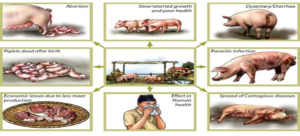
Fig : influence of housing and space allowance in swine on their wellness.
The influence of housing and space allowance on carcass features
Only a few trials take reported on the effect of infinite allocation on carcass back fat and % lean (Brumm and miller 1996). In all tests, the pigs with the least amount of space resource allotment had the leanest carcasses and the least amount of back fat depth. When compared to pigs with unrestricted pen space, a reduction in pen space allowance resulted in reduced dorsum fat and dressing per centum (Morrison et al. 2003). Increased social force per unit area in pigs with limited pen space may take resulted in recurring stimulation of the sympathetic-adrenal medulla axis or the hypothalamic–pituitary adrenal axis, resulting in protein and adipose tissue catabolism (Dubeski et al. 1999). Thus, social stress in the confined pen infinite could have contributed to the slimmer pigs with lower dressing percentages (Morrison et al. 2003).
The influence of housing and infinite allowance on pig behaviour
The allocation of space is a key aspect in determining social rank (Baxter 1985). When pigs are confined in cramped quarters, the dominance hierarchy becomes less stable (Jensen,1982). Crowding can amplify social vices including tail bitter, side nudging, and ear gnawing (Bryanand ewbank, 1980).
Determination
Given the ascension human population and urbanisation, the majority of squealer farmers, particularly those in peri-urban areas, are concerned almost the efficient use of available land (space). The all-time usage of pen space without compromising pig production and well-being is critical for the pork sector. Crowding has been shown to accept a negative affect on growth, feed intake, and FCR. Yet, for pigs, space is not every bit crucial every bit other resource, such as food and the environment. 1 of the most essential aspects in determining social continuing is infinite assart. It is found that, based on current practises, a floor space reduction of more than than 33 percentage in contrast to requirements can be suggested without jeopardising pig welfare. Investigations are needed to validate the flooring infinite need for different types of pigs, in varied group sizes, and under diverse environmental atmospheric condition.
https://world wide web.pashudhanpraharee.com/pig-farming-in-india-breeding-feeding-housing-management/
https://agritech.tnau.ac.in/animal_husbandry/ani_pig_housing%20of%20pig.html
REFERENCES
- Anil L, Anil South S and Deen J. 2007. Effects of allometric space allowance and weight grouping composition on grower-finisher pigs. Canadian Journal of Animal Science 87: 139–51.
- Basic Animal Husbandry Statistics (BAHFS). 2018. Section of Animal Husbandry, Dairying and Fisheries. Ministry of Agronomics, Government of Bharat. Retrieved December two, 2018 (http//www.dahd.nic.in).
- Baxter One thousand. 1985. Social Space Requirements of Pigs: Social Space for Domestic Animals, pp 116–27. Kluwer Academic Publishers, Hingham, MA, Usa.
- Bhat P N, Mohan Northward H and Sukh Deo. 2010. Pig product. Studium Press (Republic of india) Pvt. Ltd, Darya Ganj, New Delhi.
- Bhat P N, Mohan N H and Sukh Deo. 2010. Pig production. Studium Press (India) Pvt. Ltd, Darya Ganj, New Delhi
- Brumm M C and Miller P South. 1996. Response of pigs to space allocation and diets varying in nutrient density. Journal of Animal Scientific discipline 74: 2730–37.
- Brumm Chiliad. 2010. Designing production facilities for pig condolement in Argentinian conditions.
- Cameron R D A. 2000. A review of the industrialization of hog production worldwide with particular reference to the asian region. Animal Health and Expanse-wide Integration. FAO, Brisbane, Commonwealth of australia.
- Cho J H and Kim I H. 2011. Outcome of stocking density on squealer production. African Periodical of Biotechnology 10(63): 13688– 92.
- Gonyou H W, Brumm M C, Due east Bush-league J, Deen Due south A, Edwards T, Fangman J J, McGlone Grand, Meunier-Salaun R B, Morrison H, Spoolder P Fifty, Sundberg and Johnson A K. 2006. Application of cleaved-line assay to assess floor space requirements of nursery and grower-finisher pigs
- IS 3916(1966): code of do for grunter housing [FAD 5: livestock feeds, equipment and systems].
- Jensen P. 1982. An assay of agonistic interaction patterns in grouping-housed dry sows-aggression regulation through an 'avoidance gild'. Applied Brute Ethology 9: 47–61
- Kaswan S, Patel B H Thou, Mondal Due south 1000, Dutt T and Verma Chiliad R. 2015. Event of floor space allowance on the performance of crossbred weaner barrows. Indian Periodical of Animal Research 49(2): 241–47.
- Kornegay Eastward T, Lindemann M D and Ravindran 5. 1993. Effects of dietary lysine levels on performance and immune response of weanling pigs housed at two flooring space allowances. Journal of Animal Scientific discipline 71: 552–56.
- Morrison R S, Hemsworth P H, Cronin Thou M and Campbell R G. 2003. The consequence of restricting pen infinite and feeder availability on the behaviour and growth operation of entire male growing pigs in a deep-litter, large group housing organization. Practical Beast Behaviour Science 83: 163–76.
- Petherick J C, Beattie A W and Bodero D A V. 1989. The effect of group size on the functioning of growing pigs. Fauna Production 49: 497–502.
- Petherick J C. 2007. Spatial requirements of animals: Allometry and beyond. Journal of Veterinary Beliefs 2: 197–204.
- Prasad R, Singh A K and Singh L. 2011. Higher adjustability and economic render from pigs overshadows social taboos. Indian Enquiry Journal of Extension Education xi(i): 103–06.
- Sharma P K, Saikia S and Baruah Thou M. 2004. Effect of stocking density on growth performance and feed efficiency of Hampshire grower pigs reared nether identical feeding and management. Indian Veterinary Periodical 81(3): 299–301.
- Sinha S K, Singh R A, Sharma B D and Dubey C. 1990. Outcome of flooring space on quantitative carcass characters of Big White Yorkshire. Indian Periodical of Animal Sciences 60(8): 1006– 07.
- Smith L F, Beaulieu A D, Patience J F, Gonyou H Westward and Boyd R D. 2004. The impact of feeder adjustment and grouping size-floor infinite allowance on the performance of nursery pigs. Periodical of Swine Health and Production 12(iii): 111–18.
- Turner S P, Ewen M, Rooke J A and Edwards S A. 2000. The upshot of space assart on performance, assailment and immune competence of growing pigs housed on harbinger deeplitter at different group sizes. Livestock Production Scientific discipline 66: 47–55.
Please follow and like the states:
Source: https://www.pashudhanpraharee.com/housing-requirements-for-different-categories-of-pigs/#:~:text=Location%20of%20pig%20houses,-Structures%20should%20be&text=Structures%20should%20be%20at%20least,away%20from%20slaughterhouses%20and%20tanneries.

0 Response to "How Close Can Pigs Be To Houses"
Post a Comment